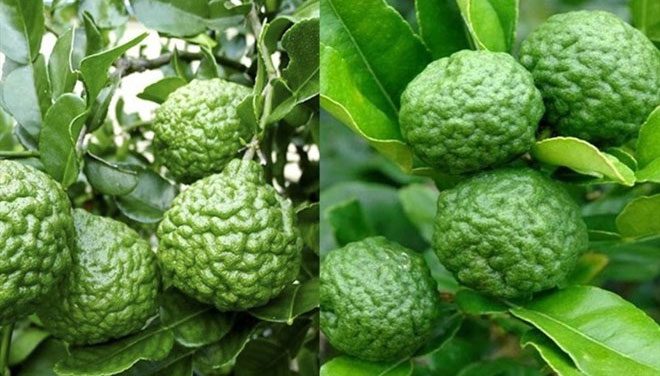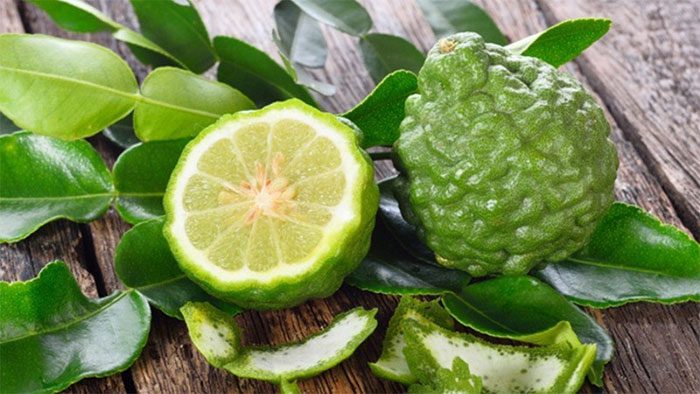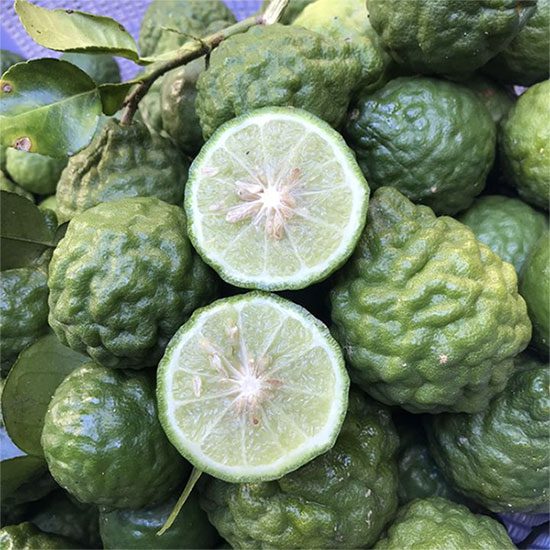The Kaffir lime is a citrus fruit rich in antioxidants, offering numerous health benefits such as enhancing cardiovascular health and reducing anxiety…
Health Benefits of Kaffir Lime
- Learn About Kaffir Lime
- Description
- Distribution and Ecology
- Parts Used
- Chemical Composition
- Uses of Kaffir Lime
- Kaffir lime supports the treatment of digestive issues
- Stress-relieving properties of Kaffir lime
- Improves oral health
- Skin protective effects from Kaffir lime
- Boosts immunity
- Anti-inflammatory effects of Kaffir lime
- Kaffir lime helps in hair care and protection
- Insect repellent from Kaffir lime
- Cough remedy
- Kaffir lime enhances iron absorption
- Precautions When Using
Kaffir lime is a tree native to Asia. The fruit, which is segmented, is considered a specialty of An Giang Province. All parts of the plant have various uses, particularly in culinary applications.
Learn About Kaffir Lime
Kaffir lime (Citrus hystrix) is the fruit of the Kaffir lime tree. The term “Kaffir” originates from the German word “Kafer,” meaning “bug,” due to the fruit’s insect-like appearance.
It belongs to the Rutaceae family.

Kaffir lime is one of the specialty fruits of An Giang Province.
Description
Kaffir lime is a small to medium-sized woody tree, growing to about 2 to 11 meters tall, with horizontal thorns.
The leaves are arranged alternately, with no stipules, and are elongated oval in shape. The top side is dark green, while the underside is lighter, and they have a strong aroma. The leaf petiole expands into distinct wings. The base of the leaf is square or round. The leaves are often chopped to be used as seasoning in many Southeast Asian dishes such as soups, curries, rice, and salads.
The flowers are small, fragrant, and white. The calyx has four lobes and is white with purple edges. The petals are elongated oval, light yellow with a hint of pink.
The fruit is large and round or egg-shaped, bumpy and wrinkled. Initially green, it turns yellow when ripe, with a diameter of 5–7 cm. The thick rind has a light yellow pulp that is very sour and bitter. The rind is often used as a seasoning in diced or crushed form. It has many seeds that are ridged and elongated.
Distribution and Ecology
Kaffir lime is originally from Asia and is indigenous to Laos, Indonesia, Malaysia, Thailand, and more. In Vietnam, it is endemic to the Ba Na Mountains in An Giang Province. Currently, Kaffir lime is widely cultivated around the world for its culinary, aromatic, and cosmetic applications.
The Kaffir lime tree is easy to grow, hardy, and drought-resistant. It is harvested once a year during the rainy season.
Parts Used
The fruit and leaves of Kaffir lime are commonly used in Southeast Asian cuisine to impart a unique, aromatic, and spicy flavor to various dishes.
The leaves can be used fresh or dried and can be frozen for preservation. They are widely used in Thai cuisine, such as in Tom Yum soup. The juice from the fruit is often used to add sourness to dishes.
It can also be added to fish or meat to enhance tenderness and aroma or to flavor grilled fish and beef. Additionally, it can be made into refreshing beverages.
The essential oil of Kaffir lime is used in perfumes.
Chemical Composition
The compounds that give Kaffir lime its distinctive aroma include citronellal, which makes up 80% of the essential oil from the leaves, with other components including citronellol (10%), nerol, and limonene.
- Carbs: 7 grams.
- Protein: 0.5 grams.
- Fat: 0.1 grams.
- Fiber: 1.9 grams.
- Vitamin C: 22% of the daily reference value.
- Iron: 2% of the daily reference value.
- Calcium: 2% of the daily reference value.
- Vitamin B6: 2% of the daily reference value.
- Thiamine: 2% of the daily reference value.
- Potassium: 1% of the daily reference value.
Uses of Kaffir Lime
Kaffir lime supports the treatment of digestive issues
The Kaffir lime contains components that have anti-inflammatory effects and stimulate the digestive system. The juice from the fruit can alleviate constipation and indigestion, helping to restore normal bowel function. This also helps prevent digestive-related issues such as colorectal cancer, hemorrhoids, or stomach ulcers.

Kaffir lime reduces stress and anxiety.
Stress-relieving properties of Kaffir lime
The essential oil extracted from the leaves or rind helps to reduce stress and anxiety. They are beneficial in aromatherapy treatments. If you are feeling anxious or have a nervous disorder, inhaling the steam from Kaffir lime essential oil can soothe both body and mind.
Improves oral health
Kaffir lime is beneficial for oral health protection, thanks to the essential oils from the rind and leaves. Rubbing them directly on the gums can enhance oral health and eliminate harmful bacteria that accumulate in the mouth. The oil extracted from Kaffir lime can be mixed with toothpaste and mouthwash for better dental and gum care.
Skin protective effects from Kaffir lime
Extracts from Kaffir lime are mixed into cosmetics and body washes for fragrance and to harness the antioxidant properties of the plant. The antioxidants slow down cell death and reduce the appearance of blemishes, scars, and acne. If you want your skin to look healthy and youthful as you age, use the juice from Kaffir lime.
Boosts immunity
The antibacterial and antioxidant properties of Kaffir lime help strengthen the immune system. The rind and leaves can be applied topically to prevent infections and the accumulation of bacteria, as well as to prevent digestive diseases, promoting immunity through their antioxidant effects.
Anti-inflammatory effects of Kaffir lime
Kaffir lime can be used to treat those suffering from rheumatoid arthritis, arthritis, edema, gout, or other infections. Juice, leaves, or extracted oil can be applied to the area experiencing discomfort or pain. Additionally, it can help with headaches and migraines.
Kaffir lime helps in hair care and protection
The juice from Kaffir lime leaves is beneficial for hair care. It can be applied as a decoction and mixture to the scalp and hair to slow the onset of balding in men and strengthen hair follicles. Additionally, it helps moisturize the scalp, preventing dandruff, and enhances hair shine.

Kaffir lime can be used to treat those suffering from rheumatoid arthritis, arthritis, edema…
The distinctive aroma of Kaffir lime also helps eliminate the fishy smell of high-protein dishes such as beef, chicken, eel, and snake. Crumpling a few leaves and placing them in a sachet will spread their fragrance throughout the air.
Insect repellent from Kaffir lime
Kaffir lime is frequently used for its insect-repelling properties. Citronellol and limonene found in Kaffir lime are unappealing to most insects. Applying a lotion or oil containing Kaffir lime essential oil to the skin can significantly reduce the likelihood of insect bites.
Cough remedy
A severe cough can be bothersome in daily communication and activities. When experiencing a cough, it can be treated by steaming Kaffir lime with honey or sugar and pouring it into a cup of warm water. The vitamin C extract in Kaffir lime leaves helps alleviate coughing and provides a clean and fresh throat.
Kaffir lime enhances iron absorption
Iron is a necessary mineral for red blood cell production and oxygen transport in the body.
Low iron levels in the blood can lead to iron deficiency anemia. Symptoms of iron deficiency anemia include fatigue, shortness of breath during exercise, paleness, and dry skin and hair.
Individuals on a vegan or vegetarian diet are at a higher risk for iron deficiency anemia, as plant-based sources of iron are not absorbed as well as iron from meat and other animal products.
Kaffir lime is a food rich in vitamin C, which helps prevent iron deficiency anemia by enhancing iron absorption from plant-based foods.
A study on individuals following a vegetarian diet found that drinking a glass of Kaffir lime juice with a vegetarian meal increased iron absorption by up to 70%.
Precautions When Using
C. hystrix in this fruit contains a significant amount of furanocoumarins in the rind and pulp. Furanocoumarins are known to cause dermatitis.
Using large amounts over extended periods may lead to:
- Enamel erosion.
- Nausea and vomiting.
- Heartburn.
- Other digestive issues.
Therefore, it is advisable to consult a doctor when considering long-term use.


















































